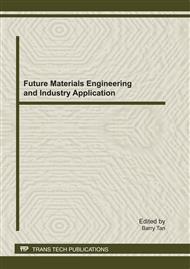[1]
L. Yang, T. Kumagai, H. Kawamura, T. Watanabe, M. Kubota, S. Fujimura, et al, Effects of rice proteins from two cultivars, Koshihikari and Shunyo, on cholesterol and triglyceride metabolism in growing and adult rats, Biosci. Biotechnol. Bioches, vol. 71, no. 3, pp.694-703, March (2007).
DOI: 10.1271/bbb.60480
Google Scholar
[2]
L. Yang and M. Kadowaki, Effects of rice proteins from two cultivars, Koshihikari and Shunyo, on hepatic cholesterol secretion by isolated perfused livers of rats fed cholesterol-enriched diets, Ann. Nutr. Metab, vol. 54, no. 4, pp.283-290, (2009).
DOI: 10.1159/000230671
Google Scholar
[3]
G.B. Cagampang, L.J. Cruz, S.G. Espiritu, R.G. Santiago, and B.O. Juliano, Studies on the extraction and composition of rice proteins, Cereal Chem, vol. 43, pp.145-155, (1966).
Google Scholar
[4]
K. Tanaka, T. Sugimoto, M. Ogawa, and Z. Kasai, Isolation and characterization of two types of protein bodies in the rice endosperm, Agric. Biol. Chem, vol. 44, pp.1633-639, (1980).
DOI: 10.1080/00021369.1980.10864167
Google Scholar
[5]
N. Kato and K. Iwami, Resistant protein: its existence and function beneficial to health, J. Nutr. Sci. Vitaminol, vol. 48, pp.1-5, (2002).
DOI: 10.3177/jnsv.48.1
Google Scholar
[6]
L. Yang, S. Wang, L. Zhang, R. Watanabe, and M. Kadowaki, Rice protein levels afftect body weight and lipids level in adult rats, J. Huazhong Agri. Uni, vol. 29, no. 6, pp.587-591, Dec. (2010).
Google Scholar
[7]
U.K. Laemmli, Cleavage of structural proteins during the assembly of the head of bacteriophage T4, Nature, vol. 227, pp.680-685, (1970).
DOI: 10.1038/227680a0
Google Scholar
[8]
Association of Official Agricultural Chemists, AOAC Official Methods of Analysis, 16th ed., Washington: 1995, p.17.
Google Scholar
[9]
M.M. Bradford, A rapid and sensitive method for the quantitation of microgram quantities of protein utilizing the principle of protein-dye binding, Anal. Biochem, vol. 72, pp.248-254, (1976).
DOI: 10.1016/0003-2697(76)90527-3
Google Scholar
[10]
T. Sugimoto, K. Tanaka, and Z. Kasai, Improved extraction of rice prolamin, Agric. Biol. Chem, vol. 50, no. 9, pp.2409-2411, (1986).
DOI: 10.1080/00021369.1986.10867759
Google Scholar


